Business Finance Report: Cash Flow, Budgeting, and Cost Management
VerifiedAdded on 2023/01/18
|10
|3154
|40
Report
AI Summary
This report provides a comprehensive analysis of business finance, focusing on cash flow management, profit and loss, and working capital. Part A delves into the importance of cash flow planning, examining its relationship with profit and loss, and the significance of working capital components like...

BUSINESS FINANCE
Paraphrase This Document
Need a fresh take? Get an instant paraphrase of this document with our AI Paraphraser
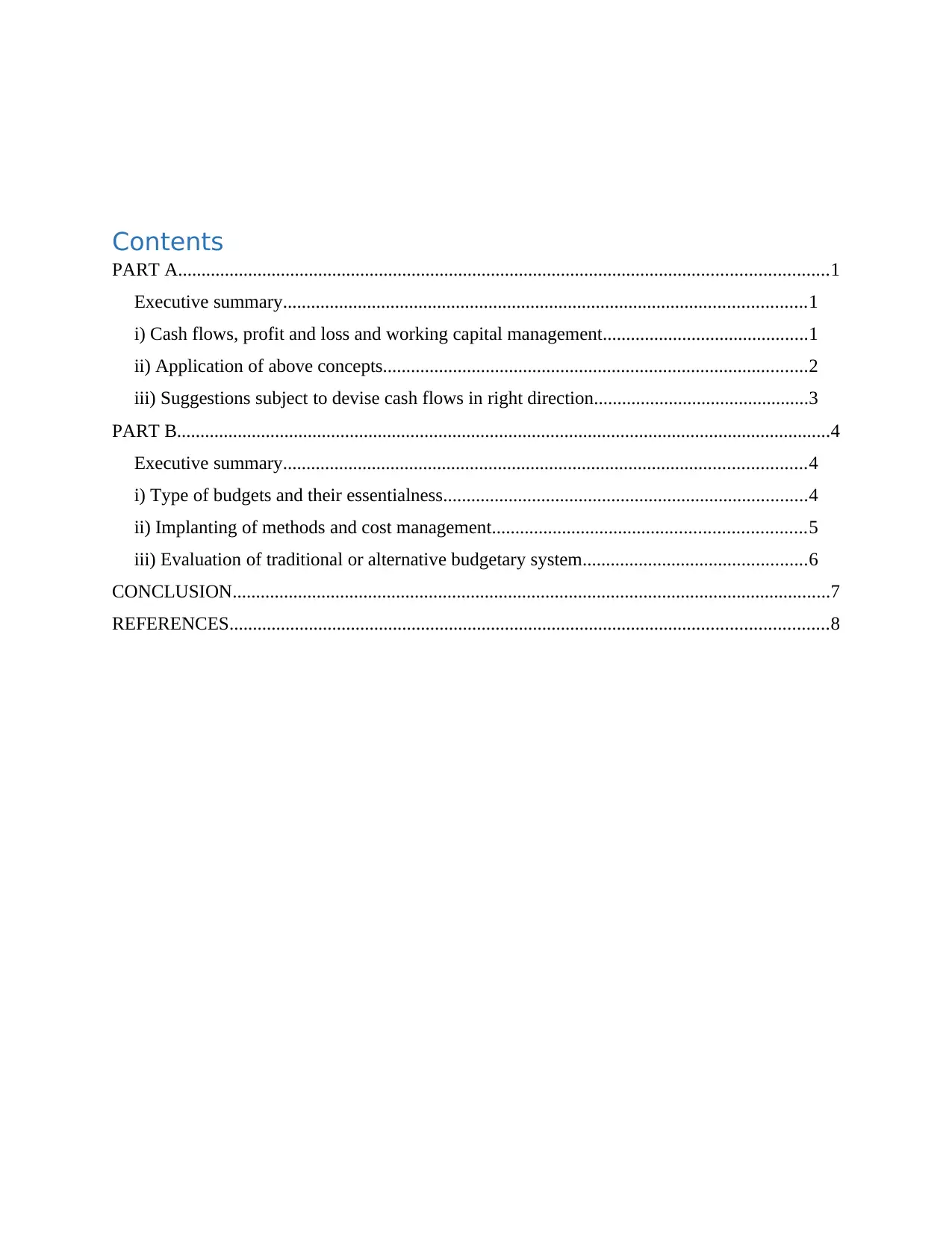
Contents
PART A...........................................................................................................................................1
Executive summary................................................................................................................1
i) Cash flows, profit and loss and working capital management............................................1
ii) Application of above concepts...........................................................................................2
iii) Suggestions subject to devise cash flows in right direction..............................................3
PART B............................................................................................................................................4
Executive summary................................................................................................................4
i) Type of budgets and their essentialness..............................................................................4
ii) Implanting of methods and cost management...................................................................5
iii) Evaluation of traditional or alternative budgetary system................................................6
CONCLUSION................................................................................................................................7
REFERENCES................................................................................................................................8
PART A...........................................................................................................................................1
Executive summary................................................................................................................1
i) Cash flows, profit and loss and working capital management............................................1
ii) Application of above concepts...........................................................................................2
iii) Suggestions subject to devise cash flows in right direction..............................................3
PART B............................................................................................................................................4
Executive summary................................................................................................................4
i) Type of budgets and their essentialness..............................................................................4
ii) Implanting of methods and cost management...................................................................5
iii) Evaluation of traditional or alternative budgetary system................................................6
CONCLUSION................................................................................................................................7
REFERENCES................................................................................................................................8
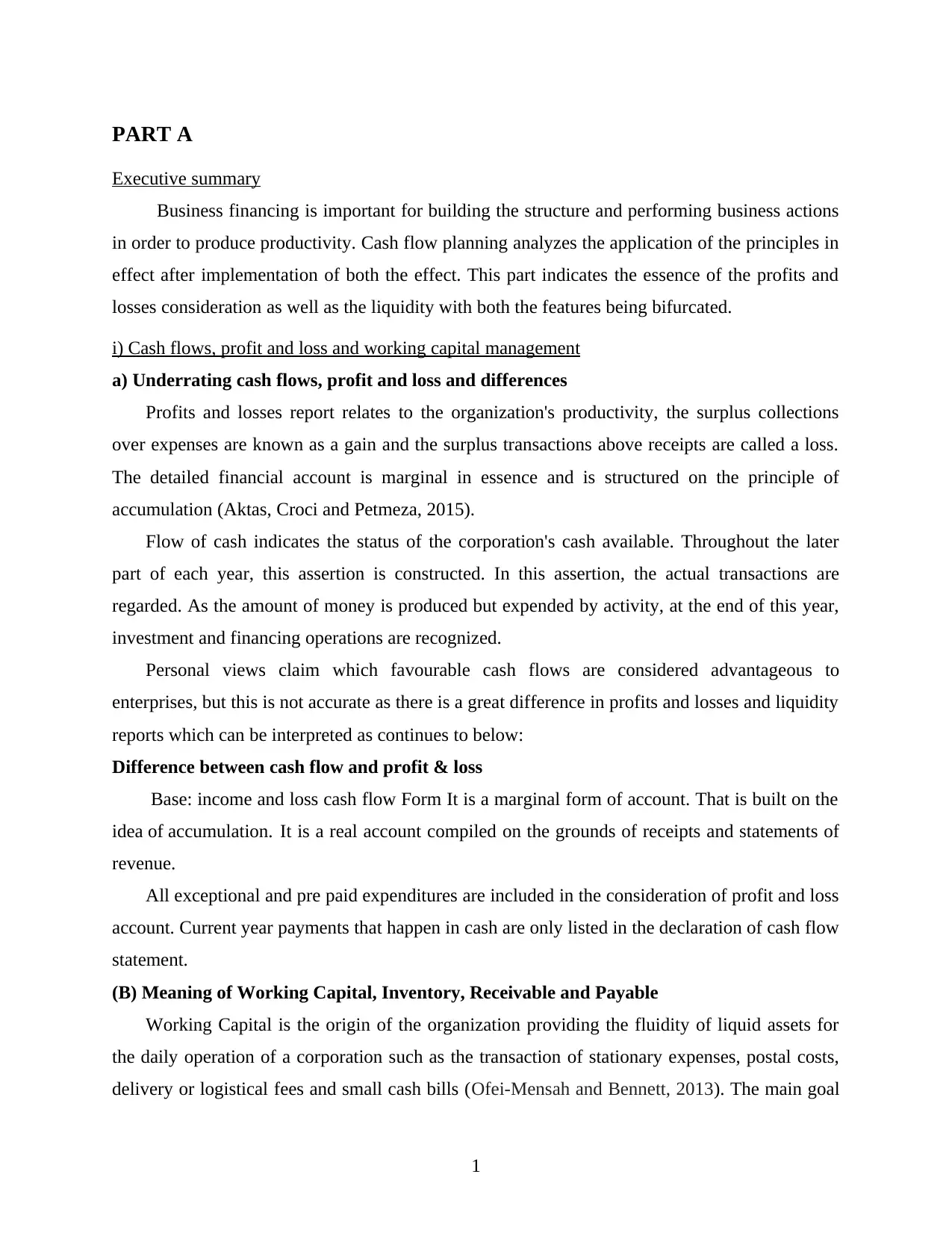
PART A
Executive summary
Business financing is important for building the structure and performing business actions
in order to produce productivity. Cash flow planning analyzes the application of the principles in
effect after implementation of both the effect. This part indicates the essence of the profits and
losses consideration as well as the liquidity with both the features being bifurcated.
i) Cash flows, profit and loss and working capital management
a) Underrating cash flows, profit and loss and differences
Profits and losses report relates to the organization's productivity, the surplus collections
over expenses are known as a gain and the surplus transactions above receipts are called a loss.
The detailed financial account is marginal in essence and is structured on the principle of
accumulation (Aktas, Croci and Petmeza, 2015).
Flow of cash indicates the status of the corporation's cash available. Throughout the later
part of each year, this assertion is constructed. In this assertion, the actual transactions are
regarded. As the amount of money is produced but expended by activity, at the end of this year,
investment and financing operations are recognized.
Personal views claim which favourable cash flows are considered advantageous to
enterprises, but this is not accurate as there is a great difference in profits and losses and liquidity
reports which can be interpreted as continues to below:
Difference between cash flow and profit & loss
Base: income and loss cash flow Form It is a marginal form of account. That is built on the
idea of accumulation. It is a real account compiled on the grounds of receipts and statements of
revenue.
All exceptional and pre paid expenditures are included in the consideration of profit and loss
account. Current year payments that happen in cash are only listed in the declaration of cash flow
statement.
(B) Meaning of Working Capital, Inventory, Receivable and Payable
Working Capital is the origin of the organization providing the fluidity of liquid assets for
the daily operation of a corporation such as the transaction of stationary expenses, postal costs,
delivery or logistical fees and small cash bills (Ofei-Mensah and Bennett, 2013). The main goal
1
Executive summary
Business financing is important for building the structure and performing business actions
in order to produce productivity. Cash flow planning analyzes the application of the principles in
effect after implementation of both the effect. This part indicates the essence of the profits and
losses consideration as well as the liquidity with both the features being bifurcated.
i) Cash flows, profit and loss and working capital management
a) Underrating cash flows, profit and loss and differences
Profits and losses report relates to the organization's productivity, the surplus collections
over expenses are known as a gain and the surplus transactions above receipts are called a loss.
The detailed financial account is marginal in essence and is structured on the principle of
accumulation (Aktas, Croci and Petmeza, 2015).
Flow of cash indicates the status of the corporation's cash available. Throughout the later
part of each year, this assertion is constructed. In this assertion, the actual transactions are
regarded. As the amount of money is produced but expended by activity, at the end of this year,
investment and financing operations are recognized.
Personal views claim which favourable cash flows are considered advantageous to
enterprises, but this is not accurate as there is a great difference in profits and losses and liquidity
reports which can be interpreted as continues to below:
Difference between cash flow and profit & loss
Base: income and loss cash flow Form It is a marginal form of account. That is built on the
idea of accumulation. It is a real account compiled on the grounds of receipts and statements of
revenue.
All exceptional and pre paid expenditures are included in the consideration of profit and loss
account. Current year payments that happen in cash are only listed in the declaration of cash flow
statement.
(B) Meaning of Working Capital, Inventory, Receivable and Payable
Working Capital is the origin of the organization providing the fluidity of liquid assets for
the daily operation of a corporation such as the transaction of stationary expenses, postal costs,
delivery or logistical fees and small cash bills (Ofei-Mensah and Bennett, 2013). The main goal
1
⊘ This is a preview!⊘
Do you want full access?
Subscribe today to unlock all pages.

Trusted by 1+ million students worldwide
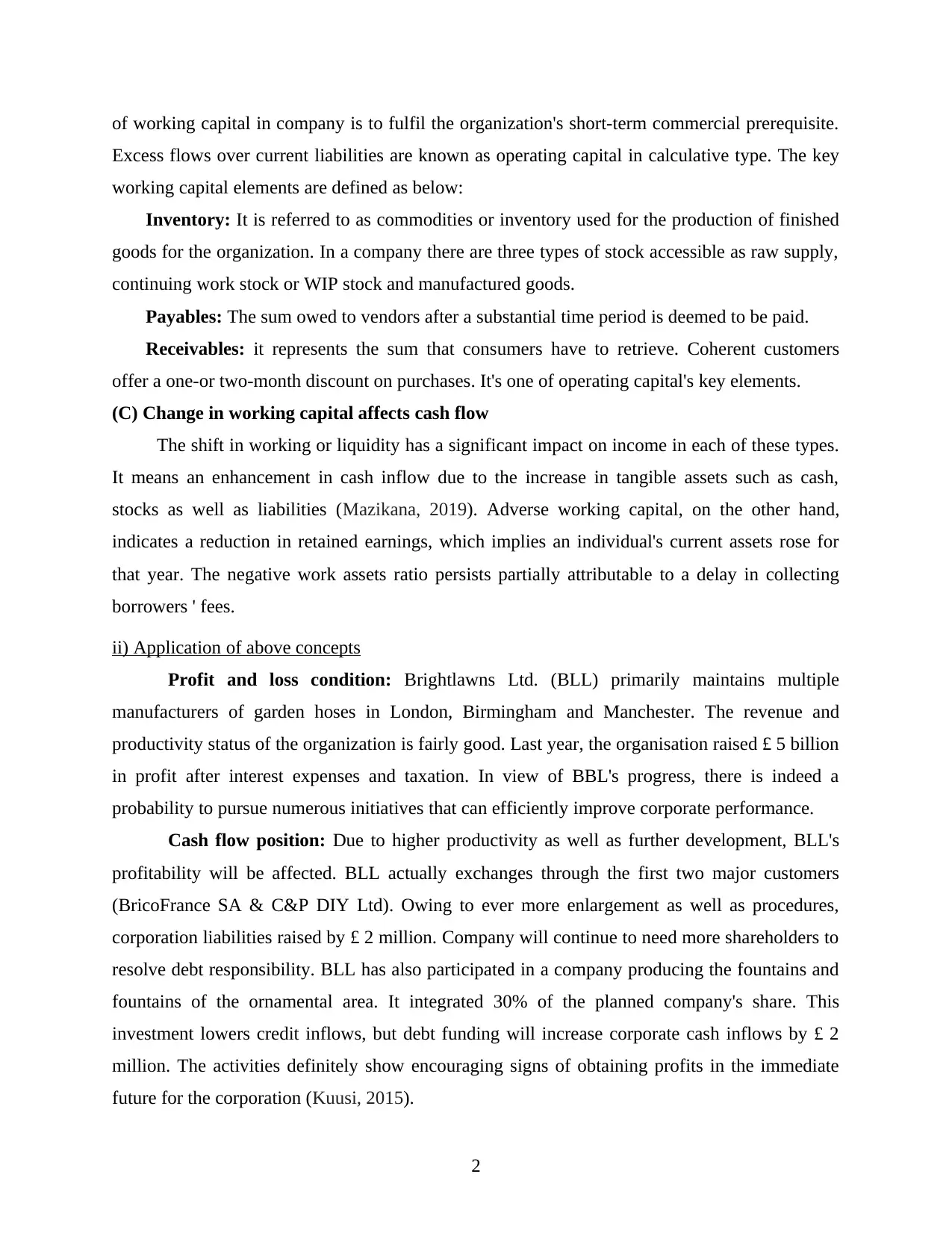
of working capital in company is to fulfil the organization's short-term commercial prerequisite.
Excess flows over current liabilities are known as operating capital in calculative type. The key
working capital elements are defined as below:
Inventory: It is referred to as commodities or inventory used for the production of finished
goods for the organization. In a company there are three types of stock accessible as raw supply,
continuing work stock or WIP stock and manufactured goods.
Payables: The sum owed to vendors after a substantial time period is deemed to be paid.
Receivables: it represents the sum that consumers have to retrieve. Coherent customers
offer a one-or two-month discount on purchases. It's one of operating capital's key elements.
(C) Change in working capital affects cash flow
The shift in working or liquidity has a significant impact on income in each of these types.
It means an enhancement in cash inflow due to the increase in tangible assets such as cash,
stocks as well as liabilities (Mazikana, 2019). Adverse working capital, on the other hand,
indicates a reduction in retained earnings, which implies an individual's current assets rose for
that year. The negative work assets ratio persists partially attributable to a delay in collecting
borrowers ' fees.
ii) Application of above concepts
Profit and loss condition: Brightlawns Ltd. (BLL) primarily maintains multiple
manufacturers of garden hoses in London, Birmingham and Manchester. The revenue and
productivity status of the organization is fairly good. Last year, the organisation raised £ 5 billion
in profit after interest expenses and taxation. In view of BBL's progress, there is indeed a
probability to pursue numerous initiatives that can efficiently improve corporate performance.
Cash flow position: Due to higher productivity as well as further development, BLL's
profitability will be affected. BLL actually exchanges through the first two major customers
(BricoFrance SA & C&P DIY Ltd). Owing to ever more enlargement as well as procedures,
corporation liabilities raised by £ 2 million. Company will continue to need more shareholders to
resolve debt responsibility. BLL has also participated in a company producing the fountains and
fountains of the ornamental area. It integrated 30% of the planned company's share. This
investment lowers credit inflows, but debt funding will increase corporate cash inflows by £ 2
million. The activities definitely show encouraging signs of obtaining profits in the immediate
future for the corporation (Kuusi, 2015).
2
Excess flows over current liabilities are known as operating capital in calculative type. The key
working capital elements are defined as below:
Inventory: It is referred to as commodities or inventory used for the production of finished
goods for the organization. In a company there are three types of stock accessible as raw supply,
continuing work stock or WIP stock and manufactured goods.
Payables: The sum owed to vendors after a substantial time period is deemed to be paid.
Receivables: it represents the sum that consumers have to retrieve. Coherent customers
offer a one-or two-month discount on purchases. It's one of operating capital's key elements.
(C) Change in working capital affects cash flow
The shift in working or liquidity has a significant impact on income in each of these types.
It means an enhancement in cash inflow due to the increase in tangible assets such as cash,
stocks as well as liabilities (Mazikana, 2019). Adverse working capital, on the other hand,
indicates a reduction in retained earnings, which implies an individual's current assets rose for
that year. The negative work assets ratio persists partially attributable to a delay in collecting
borrowers ' fees.
ii) Application of above concepts
Profit and loss condition: Brightlawns Ltd. (BLL) primarily maintains multiple
manufacturers of garden hoses in London, Birmingham and Manchester. The revenue and
productivity status of the organization is fairly good. Last year, the organisation raised £ 5 billion
in profit after interest expenses and taxation. In view of BBL's progress, there is indeed a
probability to pursue numerous initiatives that can efficiently improve corporate performance.
Cash flow position: Due to higher productivity as well as further development, BLL's
profitability will be affected. BLL actually exchanges through the first two major customers
(BricoFrance SA & C&P DIY Ltd). Owing to ever more enlargement as well as procedures,
corporation liabilities raised by £ 2 million. Company will continue to need more shareholders to
resolve debt responsibility. BLL has also participated in a company producing the fountains and
fountains of the ornamental area. It integrated 30% of the planned company's share. This
investment lowers credit inflows, but debt funding will increase corporate cash inflows by £ 2
million. The activities definitely show encouraging signs of obtaining profits in the immediate
future for the corporation (Kuusi, 2015).
2
Paraphrase This Document
Need a fresh take? Get an instant paraphrase of this document with our AI Paraphraser

Influence on Working Capital Management: Many fiscal problems await in front of
company's director after having a viable productivity role. The company owes £ 1.5 million due
to a series of massive orders placed by C&P last year an ongoing conflict to BricoFrance in 2017
related to a consignment. If the disagreement has been settled, the overall cash flow of the
business is expected to be reduced by £ 3.5 million due to delay in settlements. Negotiating,
however, is still the issue with BricoFrance. Besides that, the completed stock product at the Uk
site is yet another factor which may lead liquidity upward that inventory level is sufficient to
sustain the rate of operating capital and retrieve the conflicts that shape the compensation
(Saleem, 2013).
iii) Suggestions subject to devise cash flows in right direction
Given BLL firm's cautionary tale above, there are variables about which administrators have
to pay attention as well as take appropriate action. The first intervention factor that
administrators need to concentrate on is allocating money generated throughout the form of
capital funding (Groebner and et. Al., 2013). It is essential to analyze whether or not debt
expense is retrieved through transactions. Its gains through investment of ornamental garden
fountains including water structures should be reallocated or used in business operations in short-
term investments. Investment in shares in the company of £ 10 m needs to reimburse £ 8 m as an
efficient surcharge for the exclusive designs, which is a key factor in reducing both liquidity and
productivity.
For order to regain compensation from lawsuits, the Finnish stock inventory at the London
location must be used. Though, the organization should compare the criteria for operating capital
with leadership. It is necessary to establish a new policy on working capital control where the
optimum level of inventory as well as the period of accepting payment from the company will be
at the first point. Last year, inventory administration at the London site has to be used to
negotiate against C&P. While punishing consumers for their transactions, it is suggested to retain
the difference among disbursements and receipts through lending not facilities to distributors.
3
company's director after having a viable productivity role. The company owes £ 1.5 million due
to a series of massive orders placed by C&P last year an ongoing conflict to BricoFrance in 2017
related to a consignment. If the disagreement has been settled, the overall cash flow of the
business is expected to be reduced by £ 3.5 million due to delay in settlements. Negotiating,
however, is still the issue with BricoFrance. Besides that, the completed stock product at the Uk
site is yet another factor which may lead liquidity upward that inventory level is sufficient to
sustain the rate of operating capital and retrieve the conflicts that shape the compensation
(Saleem, 2013).
iii) Suggestions subject to devise cash flows in right direction
Given BLL firm's cautionary tale above, there are variables about which administrators have
to pay attention as well as take appropriate action. The first intervention factor that
administrators need to concentrate on is allocating money generated throughout the form of
capital funding (Groebner and et. Al., 2013). It is essential to analyze whether or not debt
expense is retrieved through transactions. Its gains through investment of ornamental garden
fountains including water structures should be reallocated or used in business operations in short-
term investments. Investment in shares in the company of £ 10 m needs to reimburse £ 8 m as an
efficient surcharge for the exclusive designs, which is a key factor in reducing both liquidity and
productivity.
For order to regain compensation from lawsuits, the Finnish stock inventory at the London
location must be used. Though, the organization should compare the criteria for operating capital
with leadership. It is necessary to establish a new policy on working capital control where the
optimum level of inventory as well as the period of accepting payment from the company will be
at the first point. Last year, inventory administration at the London site has to be used to
negotiate against C&P. While punishing consumers for their transactions, it is suggested to retain
the difference among disbursements and receipts through lending not facilities to distributors.
3
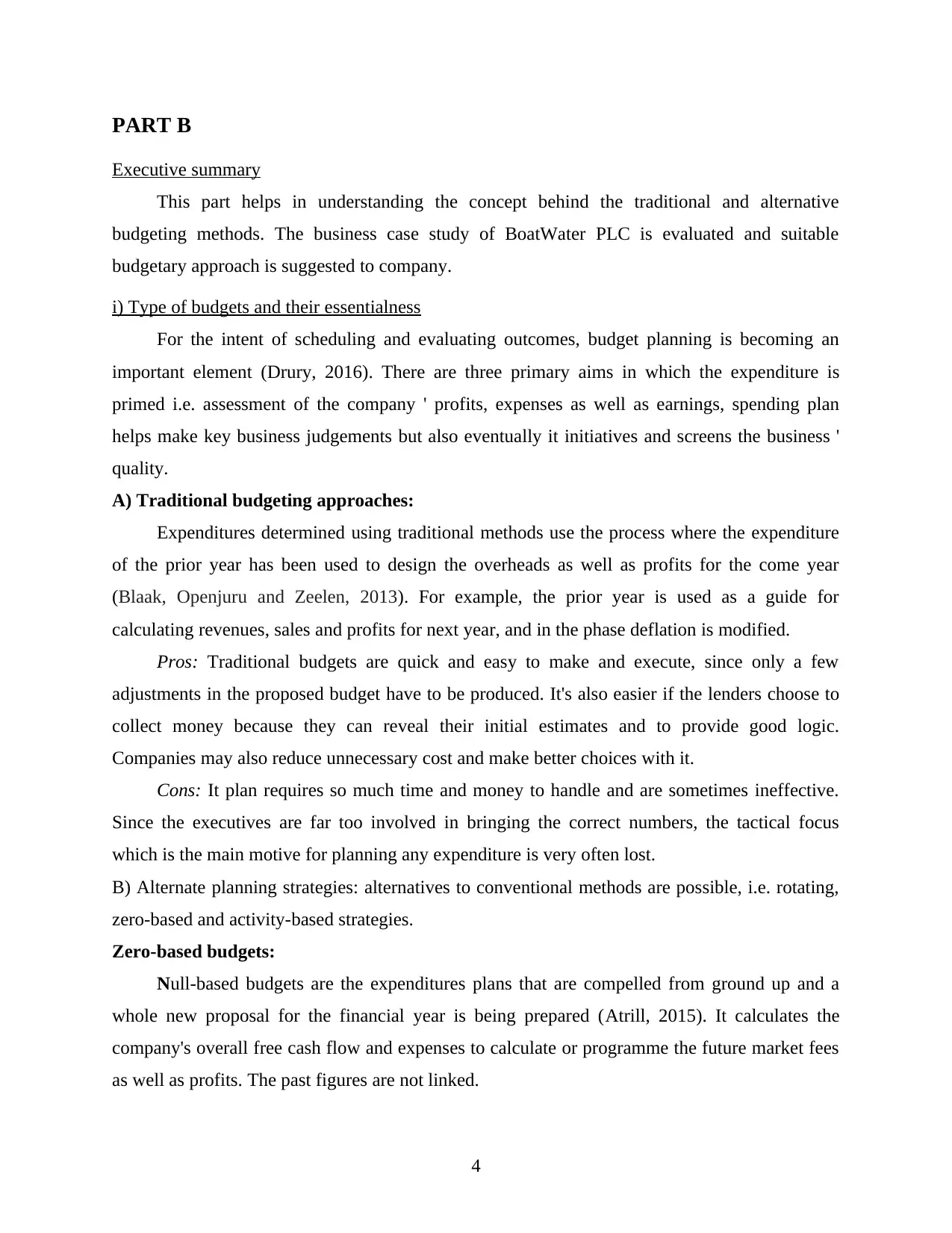
PART B
Executive summary
This part helps in understanding the concept behind the traditional and alternative
budgeting methods. The business case study of BoatWater PLC is evaluated and suitable
budgetary approach is suggested to company.
i) Type of budgets and their essentialness
For the intent of scheduling and evaluating outcomes, budget planning is becoming an
important element (Drury, 2016). There are three primary aims in which the expenditure is
primed i.e. assessment of the company ' profits, expenses as well as earnings, spending plan
helps make key business judgements but also eventually it initiatives and screens the business '
quality.
A) Traditional budgeting approaches:
Expenditures determined using traditional methods use the process where the expenditure
of the prior year has been used to design the overheads as well as profits for the come year
(Blaak, Openjuru and Zeelen, 2013). For example, the prior year is used as a guide for
calculating revenues, sales and profits for next year, and in the phase deflation is modified.
Pros: Traditional budgets are quick and easy to make and execute, since only a few
adjustments in the proposed budget have to be produced. It's also easier if the lenders choose to
collect money because they can reveal their initial estimates and to provide good logic.
Companies may also reduce unnecessary cost and make better choices with it.
Cons: It plan requires so much time and money to handle and are sometimes ineffective.
Since the executives are far too involved in bringing the correct numbers, the tactical focus
which is the main motive for planning any expenditure is very often lost.
B) Alternate planning strategies: alternatives to conventional methods are possible, i.e. rotating,
zero-based and activity-based strategies.
Zero-based budgets:
Null-based budgets are the expenditures plans that are compelled from ground up and a
whole new proposal for the financial year is being prepared (Atrill, 2015). It calculates the
company's overall free cash flow and expenses to calculate or programme the future market fees
as well as profits. The past figures are not linked.
4
Executive summary
This part helps in understanding the concept behind the traditional and alternative
budgeting methods. The business case study of BoatWater PLC is evaluated and suitable
budgetary approach is suggested to company.
i) Type of budgets and their essentialness
For the intent of scheduling and evaluating outcomes, budget planning is becoming an
important element (Drury, 2016). There are three primary aims in which the expenditure is
primed i.e. assessment of the company ' profits, expenses as well as earnings, spending plan
helps make key business judgements but also eventually it initiatives and screens the business '
quality.
A) Traditional budgeting approaches:
Expenditures determined using traditional methods use the process where the expenditure
of the prior year has been used to design the overheads as well as profits for the come year
(Blaak, Openjuru and Zeelen, 2013). For example, the prior year is used as a guide for
calculating revenues, sales and profits for next year, and in the phase deflation is modified.
Pros: Traditional budgets are quick and easy to make and execute, since only a few
adjustments in the proposed budget have to be produced. It's also easier if the lenders choose to
collect money because they can reveal their initial estimates and to provide good logic.
Companies may also reduce unnecessary cost and make better choices with it.
Cons: It plan requires so much time and money to handle and are sometimes ineffective.
Since the executives are far too involved in bringing the correct numbers, the tactical focus
which is the main motive for planning any expenditure is very often lost.
B) Alternate planning strategies: alternatives to conventional methods are possible, i.e. rotating,
zero-based and activity-based strategies.
Zero-based budgets:
Null-based budgets are the expenditures plans that are compelled from ground up and a
whole new proposal for the financial year is being prepared (Atrill, 2015). It calculates the
company's overall free cash flow and expenses to calculate or programme the future market fees
as well as profits. The past figures are not linked.
4
⊘ This is a preview!⊘
Do you want full access?
Subscribe today to unlock all pages.

Trusted by 1+ million students worldwide
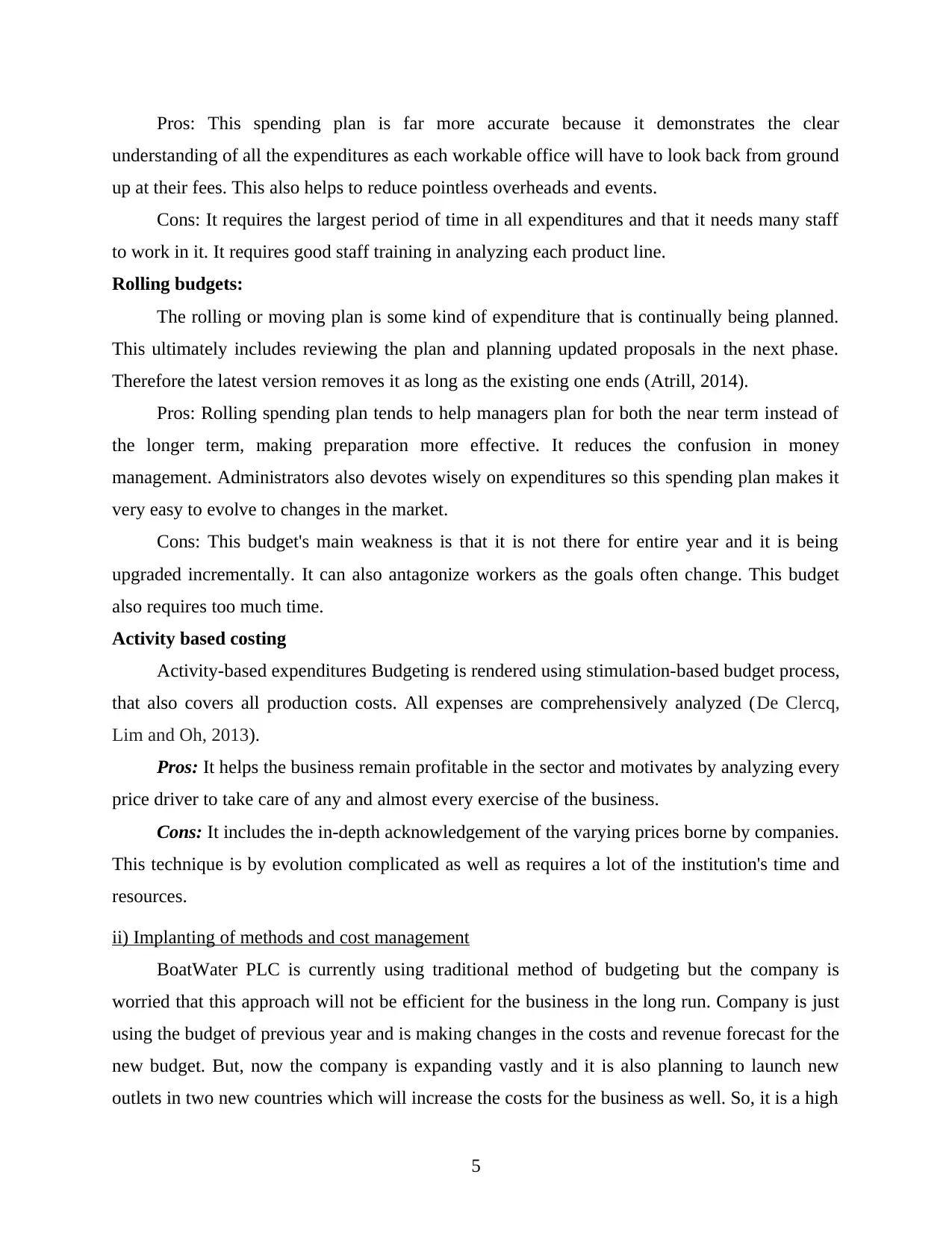
Pros: This spending plan is far more accurate because it demonstrates the clear
understanding of all the expenditures as each workable office will have to look back from ground
up at their fees. This also helps to reduce pointless overheads and events.
Cons: It requires the largest period of time in all expenditures and that it needs many staff
to work in it. It requires good staff training in analyzing each product line.
Rolling budgets:
The rolling or moving plan is some kind of expenditure that is continually being planned.
This ultimately includes reviewing the plan and planning updated proposals in the next phase.
Therefore the latest version removes it as long as the existing one ends (Atrill, 2014).
Pros: Rolling spending plan tends to help managers plan for both the near term instead of
the longer term, making preparation more effective. It reduces the confusion in money
management. Administrators also devotes wisely on expenditures so this spending plan makes it
very easy to evolve to changes in the market.
Cons: This budget's main weakness is that it is not there for entire year and it is being
upgraded incrementally. It can also antagonize workers as the goals often change. This budget
also requires too much time.
Activity based costing
Activity-based expenditures Budgeting is rendered using stimulation-based budget process,
that also covers all production costs. All expenses are comprehensively analyzed (De Clercq,
Lim and Oh, 2013).
Pros: It helps the business remain profitable in the sector and motivates by analyzing every
price driver to take care of any and almost every exercise of the business.
Cons: It includes the in-depth acknowledgement of the varying prices borne by companies.
This technique is by evolution complicated as well as requires a lot of the institution's time and
resources.
ii) Implanting of methods and cost management
BoatWater PLC is currently using traditional method of budgeting but the company is
worried that this approach will not be efficient for the business in the long run. Company is just
using the budget of previous year and is making changes in the costs and revenue forecast for the
new budget. But, now the company is expanding vastly and it is also planning to launch new
outlets in two new countries which will increase the costs for the business as well. So, it is a high
5
understanding of all the expenditures as each workable office will have to look back from ground
up at their fees. This also helps to reduce pointless overheads and events.
Cons: It requires the largest period of time in all expenditures and that it needs many staff
to work in it. It requires good staff training in analyzing each product line.
Rolling budgets:
The rolling or moving plan is some kind of expenditure that is continually being planned.
This ultimately includes reviewing the plan and planning updated proposals in the next phase.
Therefore the latest version removes it as long as the existing one ends (Atrill, 2014).
Pros: Rolling spending plan tends to help managers plan for both the near term instead of
the longer term, making preparation more effective. It reduces the confusion in money
management. Administrators also devotes wisely on expenditures so this spending plan makes it
very easy to evolve to changes in the market.
Cons: This budget's main weakness is that it is not there for entire year and it is being
upgraded incrementally. It can also antagonize workers as the goals often change. This budget
also requires too much time.
Activity based costing
Activity-based expenditures Budgeting is rendered using stimulation-based budget process,
that also covers all production costs. All expenses are comprehensively analyzed (De Clercq,
Lim and Oh, 2013).
Pros: It helps the business remain profitable in the sector and motivates by analyzing every
price driver to take care of any and almost every exercise of the business.
Cons: It includes the in-depth acknowledgement of the varying prices borne by companies.
This technique is by evolution complicated as well as requires a lot of the institution's time and
resources.
ii) Implanting of methods and cost management
BoatWater PLC is currently using traditional method of budgeting but the company is
worried that this approach will not be efficient for the business in the long run. Company is just
using the budget of previous year and is making changes in the costs and revenue forecast for the
new budget. But, now the company is expanding vastly and it is also planning to launch new
outlets in two new countries which will increase the costs for the business as well. So, it is a high
5
Paraphrase This Document
Need a fresh take? Get an instant paraphrase of this document with our AI Paraphraser
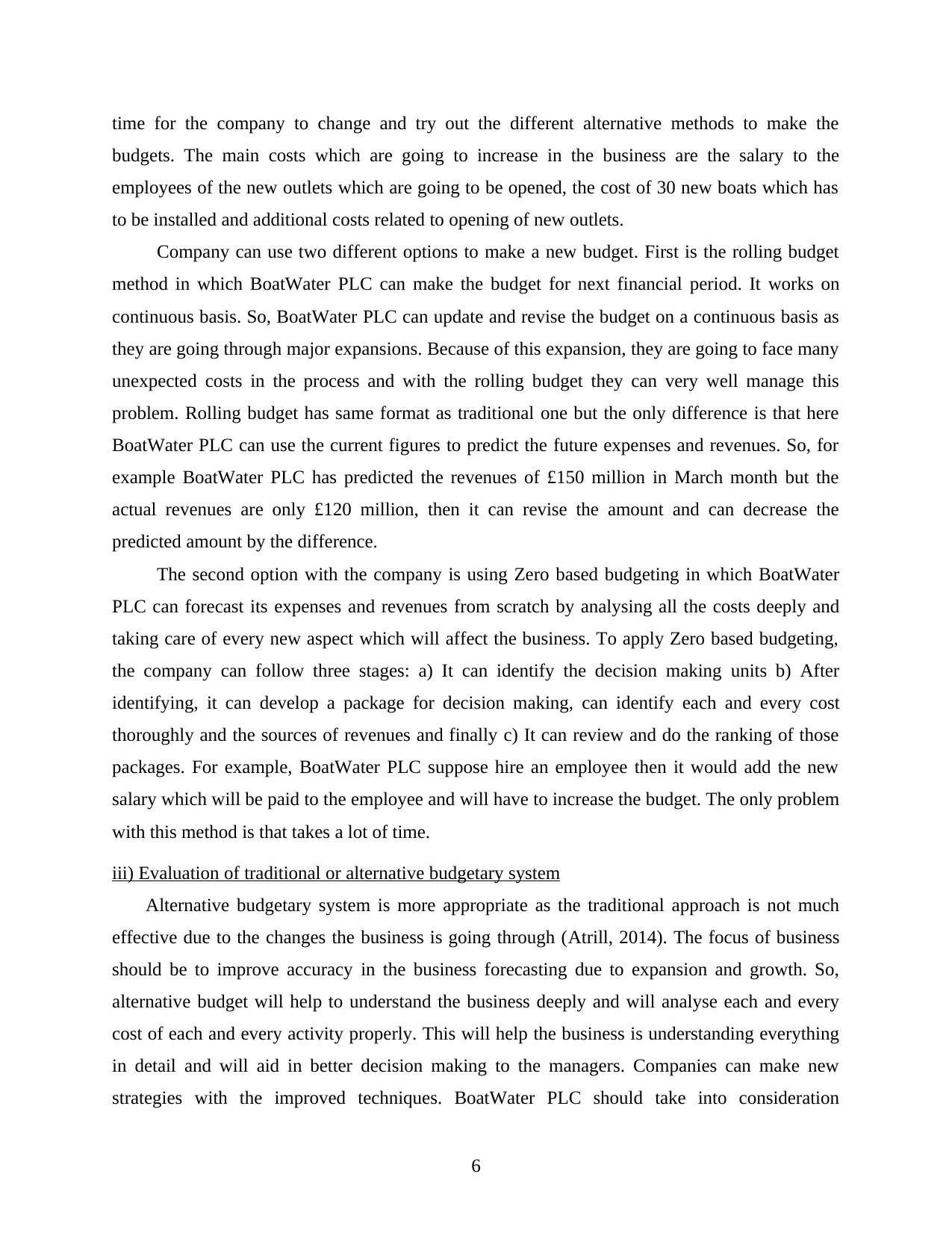
time for the company to change and try out the different alternative methods to make the
budgets. The main costs which are going to increase in the business are the salary to the
employees of the new outlets which are going to be opened, the cost of 30 new boats which has
to be installed and additional costs related to opening of new outlets.
Company can use two different options to make a new budget. First is the rolling budget
method in which BoatWater PLC can make the budget for next financial period. It works on
continuous basis. So, BoatWater PLC can update and revise the budget on a continuous basis as
they are going through major expansions. Because of this expansion, they are going to face many
unexpected costs in the process and with the rolling budget they can very well manage this
problem. Rolling budget has same format as traditional one but the only difference is that here
BoatWater PLC can use the current figures to predict the future expenses and revenues. So, for
example BoatWater PLC has predicted the revenues of £150 million in March month but the
actual revenues are only £120 million, then it can revise the amount and can decrease the
predicted amount by the difference.
The second option with the company is using Zero based budgeting in which BoatWater
PLC can forecast its expenses and revenues from scratch by analysing all the costs deeply and
taking care of every new aspect which will affect the business. To apply Zero based budgeting,
the company can follow three stages: a) It can identify the decision making units b) After
identifying, it can develop a package for decision making, can identify each and every cost
thoroughly and the sources of revenues and finally c) It can review and do the ranking of those
packages. For example, BoatWater PLC suppose hire an employee then it would add the new
salary which will be paid to the employee and will have to increase the budget. The only problem
with this method is that takes a lot of time.
iii) Evaluation of traditional or alternative budgetary system
Alternative budgetary system is more appropriate as the traditional approach is not much
effective due to the changes the business is going through (Atrill, 2014). The focus of business
should be to improve accuracy in the business forecasting due to expansion and growth. So,
alternative budget will help to understand the business deeply and will analyse each and every
cost of each and every activity properly. This will help the business is understanding everything
in detail and will aid in better decision making to the managers. Companies can make new
strategies with the improved techniques. BoatWater PLC should take into consideration
6
budgets. The main costs which are going to increase in the business are the salary to the
employees of the new outlets which are going to be opened, the cost of 30 new boats which has
to be installed and additional costs related to opening of new outlets.
Company can use two different options to make a new budget. First is the rolling budget
method in which BoatWater PLC can make the budget for next financial period. It works on
continuous basis. So, BoatWater PLC can update and revise the budget on a continuous basis as
they are going through major expansions. Because of this expansion, they are going to face many
unexpected costs in the process and with the rolling budget they can very well manage this
problem. Rolling budget has same format as traditional one but the only difference is that here
BoatWater PLC can use the current figures to predict the future expenses and revenues. So, for
example BoatWater PLC has predicted the revenues of £150 million in March month but the
actual revenues are only £120 million, then it can revise the amount and can decrease the
predicted amount by the difference.
The second option with the company is using Zero based budgeting in which BoatWater
PLC can forecast its expenses and revenues from scratch by analysing all the costs deeply and
taking care of every new aspect which will affect the business. To apply Zero based budgeting,
the company can follow three stages: a) It can identify the decision making units b) After
identifying, it can develop a package for decision making, can identify each and every cost
thoroughly and the sources of revenues and finally c) It can review and do the ranking of those
packages. For example, BoatWater PLC suppose hire an employee then it would add the new
salary which will be paid to the employee and will have to increase the budget. The only problem
with this method is that takes a lot of time.
iii) Evaluation of traditional or alternative budgetary system
Alternative budgetary system is more appropriate as the traditional approach is not much
effective due to the changes the business is going through (Atrill, 2014). The focus of business
should be to improve accuracy in the business forecasting due to expansion and growth. So,
alternative budget will help to understand the business deeply and will analyse each and every
cost of each and every activity properly. This will help the business is understanding everything
in detail and will aid in better decision making to the managers. Companies can make new
strategies with the improved techniques. BoatWater PLC should take into consideration
6
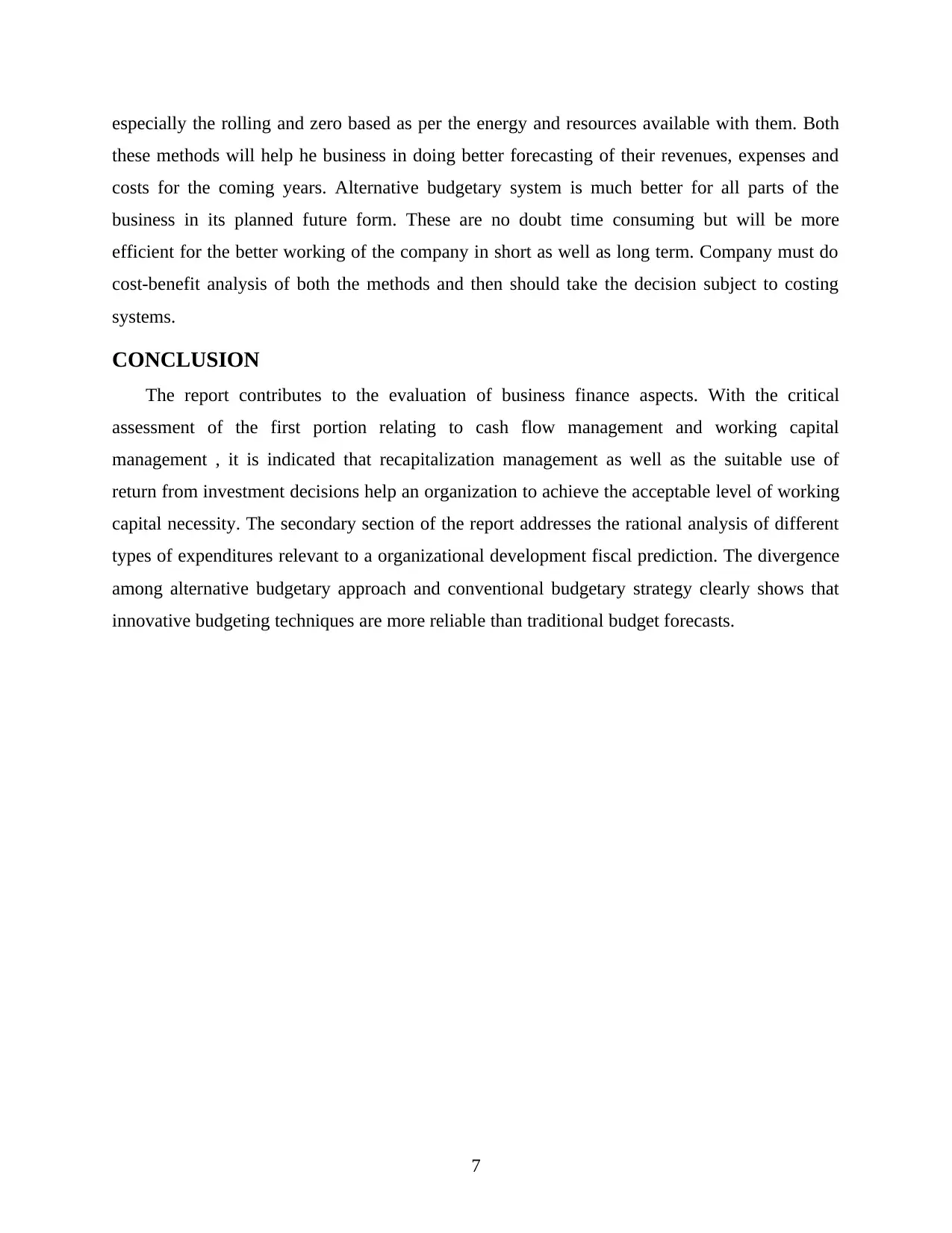
especially the rolling and zero based as per the energy and resources available with them. Both
these methods will help he business in doing better forecasting of their revenues, expenses and
costs for the coming years. Alternative budgetary system is much better for all parts of the
business in its planned future form. These are no doubt time consuming but will be more
efficient for the better working of the company in short as well as long term. Company must do
cost-benefit analysis of both the methods and then should take the decision subject to costing
systems.
CONCLUSION
The report contributes to the evaluation of business finance aspects. With the critical
assessment of the first portion relating to cash flow management and working capital
management , it is indicated that recapitalization management as well as the suitable use of
return from investment decisions help an organization to achieve the acceptable level of working
capital necessity. The secondary section of the report addresses the rational analysis of different
types of expenditures relevant to a organizational development fiscal prediction. The divergence
among alternative budgetary approach and conventional budgetary strategy clearly shows that
innovative budgeting techniques are more reliable than traditional budget forecasts.
7
these methods will help he business in doing better forecasting of their revenues, expenses and
costs for the coming years. Alternative budgetary system is much better for all parts of the
business in its planned future form. These are no doubt time consuming but will be more
efficient for the better working of the company in short as well as long term. Company must do
cost-benefit analysis of both the methods and then should take the decision subject to costing
systems.
CONCLUSION
The report contributes to the evaluation of business finance aspects. With the critical
assessment of the first portion relating to cash flow management and working capital
management , it is indicated that recapitalization management as well as the suitable use of
return from investment decisions help an organization to achieve the acceptable level of working
capital necessity. The secondary section of the report addresses the rational analysis of different
types of expenditures relevant to a organizational development fiscal prediction. The divergence
among alternative budgetary approach and conventional budgetary strategy clearly shows that
innovative budgeting techniques are more reliable than traditional budget forecasts.
7
⊘ This is a preview!⊘
Do you want full access?
Subscribe today to unlock all pages.

Trusted by 1+ million students worldwide
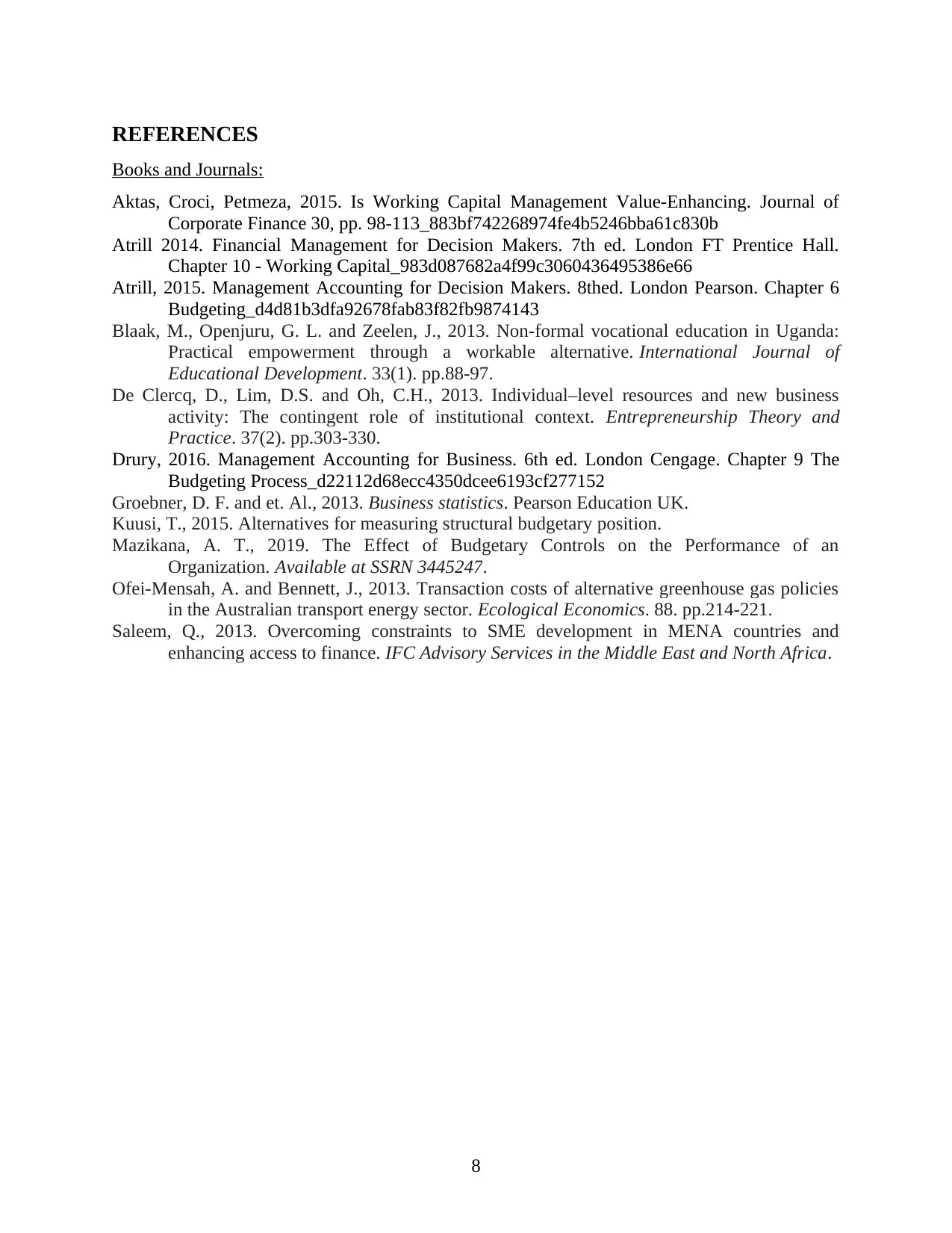
REFERENCES
Books and Journals:
Aktas, Croci, Petmeza, 2015. Is Working Capital Management Value-Enhancing. Journal of
Corporate Finance 30, pp. 98-113_883bf742268974fe4b5246bba61c830b
Atrill 2014. Financial Management for Decision Makers. 7th ed. London FT Prentice Hall.
Chapter 10 - Working Capital_983d087682a4f99c3060436495386e66
Atrill, 2015. Management Accounting for Decision Makers. 8thed. London Pearson. Chapter 6
Budgeting_d4d81b3dfa92678fab83f82fb9874143
Blaak, M., Openjuru, G. L. and Zeelen, J., 2013. Non-formal vocational education in Uganda:
Practical empowerment through a workable alternative. International Journal of
Educational Development. 33(1). pp.88-97.
De Clercq, D., Lim, D.S. and Oh, C.H., 2013. Individual–level resources and new business
activity: The contingent role of institutional context. Entrepreneurship Theory and
Practice. 37(2). pp.303-330.
Drury, 2016. Management Accounting for Business. 6th ed. London Cengage. Chapter 9 The
Budgeting Process_d22112d68ecc4350dcee6193cf277152
Groebner, D. F. and et. Al., 2013. Business statistics. Pearson Education UK.
Kuusi, T., 2015. Alternatives for measuring structural budgetary position.
Mazikana, A. T., 2019. The Effect of Budgetary Controls on the Performance of an
Organization. Available at SSRN 3445247.
Ofei-Mensah, A. and Bennett, J., 2013. Transaction costs of alternative greenhouse gas policies
in the Australian transport energy sector. Ecological Economics. 88. pp.214-221.
Saleem, Q., 2013. Overcoming constraints to SME development in MENA countries and
enhancing access to finance. IFC Advisory Services in the Middle East and North Africa.
8
Books and Journals:
Aktas, Croci, Petmeza, 2015. Is Working Capital Management Value-Enhancing. Journal of
Corporate Finance 30, pp. 98-113_883bf742268974fe4b5246bba61c830b
Atrill 2014. Financial Management for Decision Makers. 7th ed. London FT Prentice Hall.
Chapter 10 - Working Capital_983d087682a4f99c3060436495386e66
Atrill, 2015. Management Accounting for Decision Makers. 8thed. London Pearson. Chapter 6
Budgeting_d4d81b3dfa92678fab83f82fb9874143
Blaak, M., Openjuru, G. L. and Zeelen, J., 2013. Non-formal vocational education in Uganda:
Practical empowerment through a workable alternative. International Journal of
Educational Development. 33(1). pp.88-97.
De Clercq, D., Lim, D.S. and Oh, C.H., 2013. Individual–level resources and new business
activity: The contingent role of institutional context. Entrepreneurship Theory and
Practice. 37(2). pp.303-330.
Drury, 2016. Management Accounting for Business. 6th ed. London Cengage. Chapter 9 The
Budgeting Process_d22112d68ecc4350dcee6193cf277152
Groebner, D. F. and et. Al., 2013. Business statistics. Pearson Education UK.
Kuusi, T., 2015. Alternatives for measuring structural budgetary position.
Mazikana, A. T., 2019. The Effect of Budgetary Controls on the Performance of an
Organization. Available at SSRN 3445247.
Ofei-Mensah, A. and Bennett, J., 2013. Transaction costs of alternative greenhouse gas policies
in the Australian transport energy sector. Ecological Economics. 88. pp.214-221.
Saleem, Q., 2013. Overcoming constraints to SME development in MENA countries and
enhancing access to finance. IFC Advisory Services in the Middle East and North Africa.
8
1 out of 10
Related Documents
Your All-in-One AI-Powered Toolkit for Academic Success.
+13062052269
info@desklib.com
Available 24*7 on WhatsApp / Email
![[object Object]](/_next/static/media/star-bottom.7253800d.svg)
Unlock your academic potential
© 2024 | Zucol Services PVT LTD | All rights reserved.





